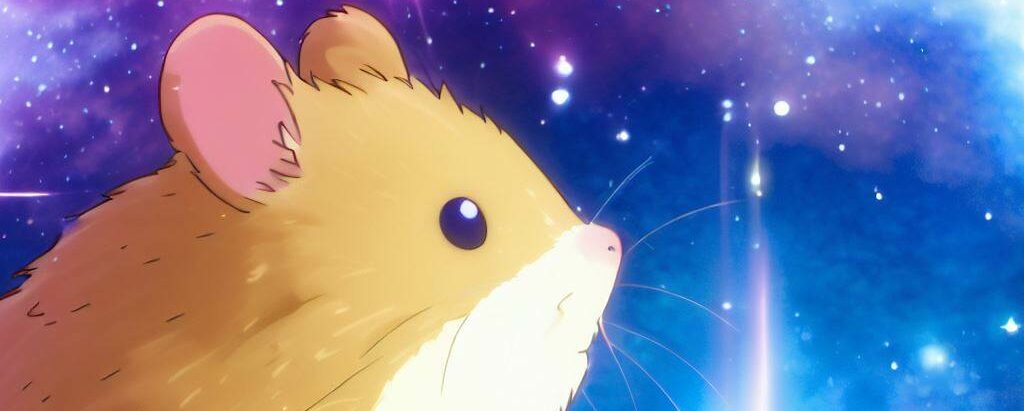We are headed into the season of the Nobel Prize. Announcements of awards will begin on October 6, with the Physics Prize being announced on the 7th. This year, I decided to have some fun in the “fediverse” and try to tease some nuggets out of the wisdom of the crowd.
While crowds are, in fact, not always wise, it is nonetheless fun to use some of the tools of the open social web to prompt conversation about the prize. As a physicist, I decided to stay focused on the question of the physics prize.
I began with a poll. The Mastodon social media platform, built atop the ActivityPub social protocol, supports polling. The polls have limits. There can only be four choices. Each choice can only be 50 characters long. In some sense, the constraints on polls in Mastodon match well with the imperfect constraints places on the Nobel Prize. There is a cap on the number of awardees (3). All awardees must be alive.
I began with this poll:
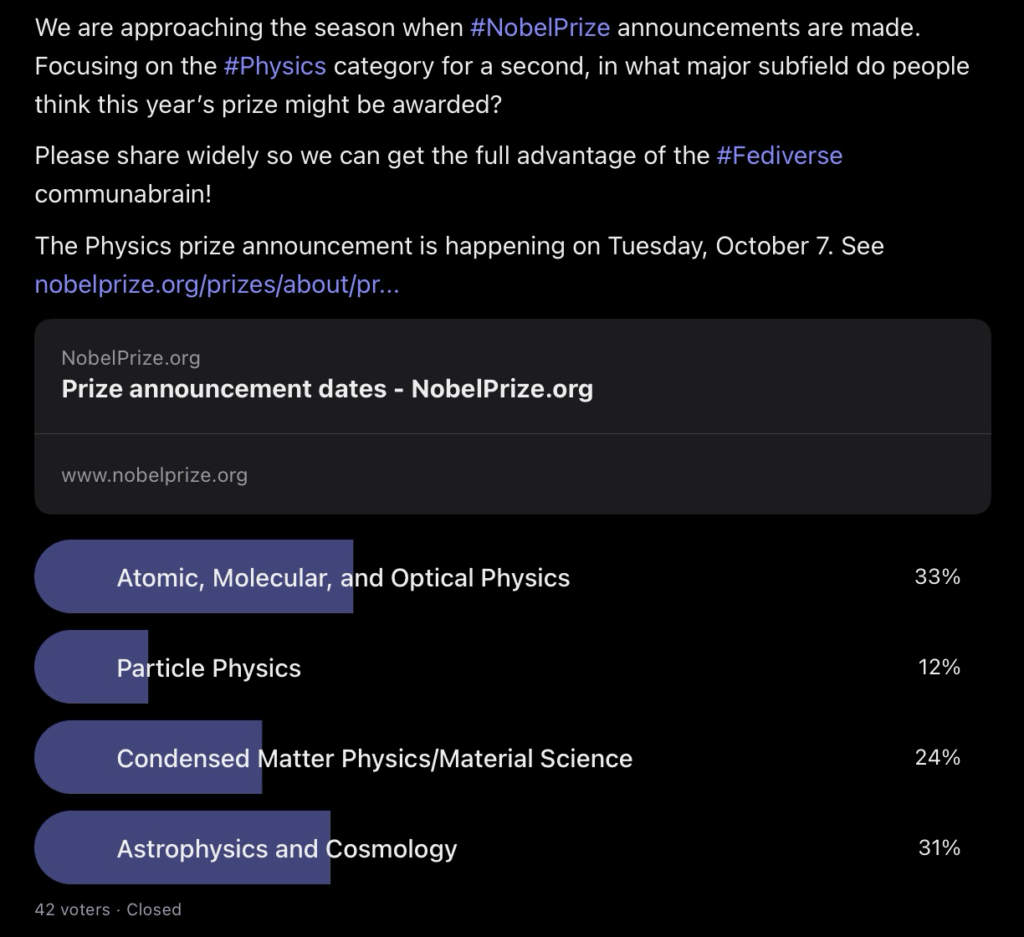
I had 42 voters participate, and the winner by a nose was Atomic, Molecular, and Optical physics (AMO) as the area where the 2025 prize would be awarded. A VERY close second choice was Astrophysics and Cosmology. Particle Physics was a distant fourth.
Condensed Matter/Material Science also includes statistical physics, which was the area of the 2024 prize in machine learning. Under the hood, making machines learn and recall is an exercise in statistical physics (e.g. thermodynamics).
The next question was, then, what discovery people might think would be worthy of the prize in either of the leading two areas: AMO or Astro/Cosmo.
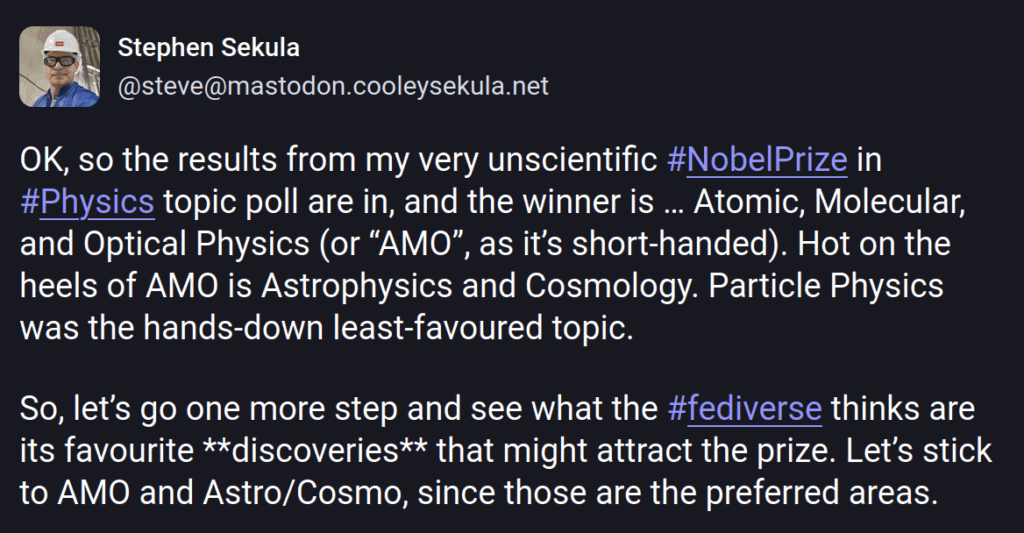
My intent was not to collect any names of potential awardees … that can be fraught with immense peril, given personal-professional relationships and the risk of mis-attribution of discovery (which even the Nobel Prize committee has fumbled in its more than century of practice). I was more curious if people on the fediverse had thoughts about the specific discovery or insight that might attract a prize in 2025.
I got two responses (so far, as of the writing of this post). I summarize them here.
The Event Horizon Telescope/Imaging of Galactic Centre Supermassive Black Holes
Less a person and more a collaboration nomination, this suggestion referred to the recent observations of a world-wide radio telescope network called the “Event Horizon Telescope”. The telescope’s primary goal was to image the supermassive black hole (SMBH) at the centre of our own galaxy. That original goal proved challenging at first, but the telescope was used to great effect to observe the supermassive black hole at the centre of the M87 galaxy!
What? How is observing the Milky Way’s SMBH, called “Sagittarius A*” or “SgrA*”, harder than observing the one in the middle of a very distance galaxy (M87*)? Sometimes the thing right in front of your face is hard to focus on. In this case, processing the Sgr A* image to the satisfaction of the collaboration was a lengthy process. Despite being 53 million light-years aware, M87* is bigger on the sky than SgrA*. That is one massive SMBH. It was actually easier for EHT to image this monster.
On April 10, 2019, the National Science Foundation and the Event Horizon Telescope collaboration held a media event [2] announcing the first-ever picture of the region around a black hole – specifically, the supermassive at the center of the galaxy M87! It was a remarkable image, and implied a mass of 6.5 billion suns. This is even larger than our own supermassive black hole is expected to be, making it possible to image in a neighboring galaxy.
Read more in “A View from the Shadows: Tune that Dial to Black Hole”

After a great deal of work within the collaboration, they released the image of SgrA* in 2022. This SMBH is much smaller in viewing size than the M87* SMBH, making this fuzzy image quite an accomplishment. This also marks the first time any telescope has taken an image of anything this close to the “point of no return” of a black hole.
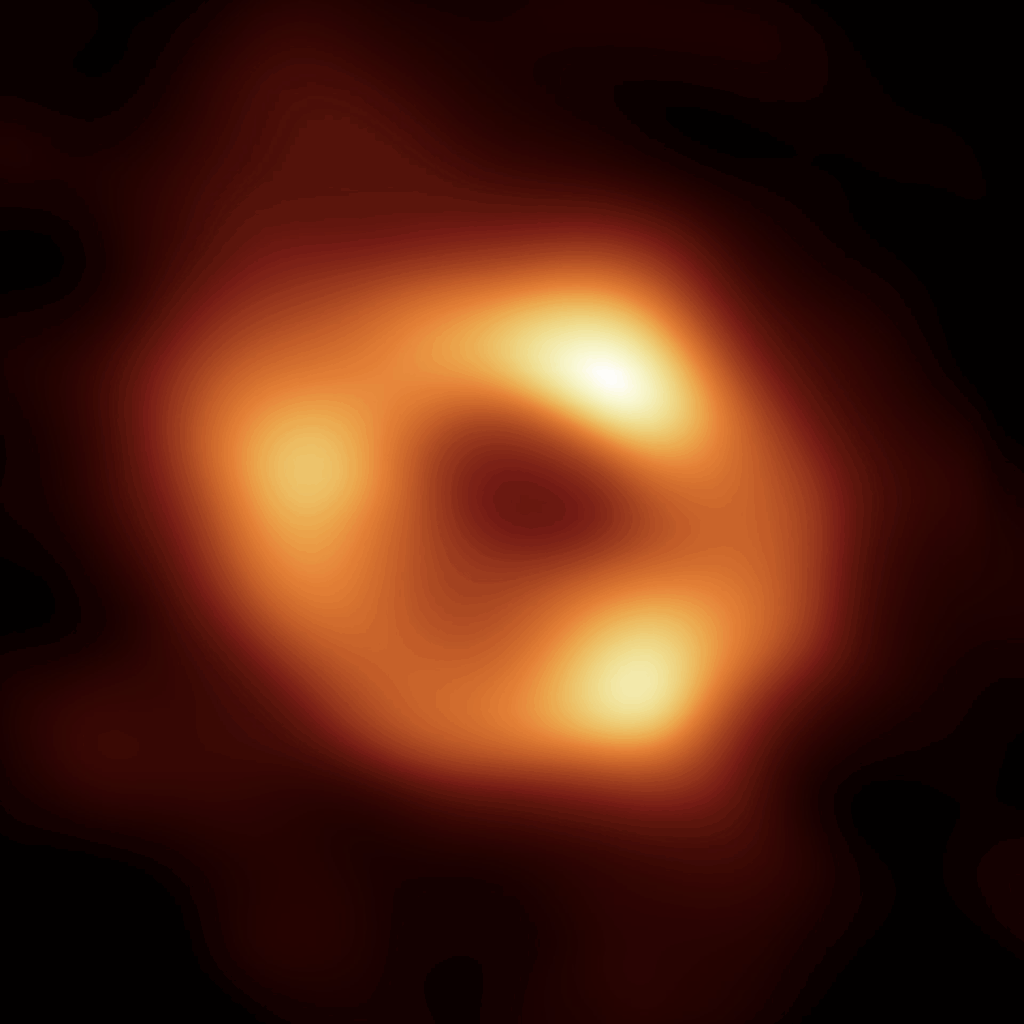
Molecular Astrochemistry
The second suggestion was actually for a specific individual, whom I will come back to in a moment. The area of focus is molecular astrochemistry – the study of molecular clouds and structures made from gas that exist between things (like stars or galaxies) and around things (like stars). Such clouds are the basis of the births of solar systems. Fundamentally, an award would recognize the broader area of astrochemistry, a recently emerged distinct subject (only decades old). This particular subject is a synthesis of AMO and Astrophysics … pretty fitting, given the results of the unscientific poll.
Specifically, the work in question here is about how you go from stellar dust clouds and disks down to life-hosting worlds with carbon-based organisms (and molecules from which those organisms are actually built). Molecules like carbon monoxide are actually abundant in space and around stars, and high energy light can break up CO and liberate both carbon and oxygen that can be used later in amino acids and other essential molecules.
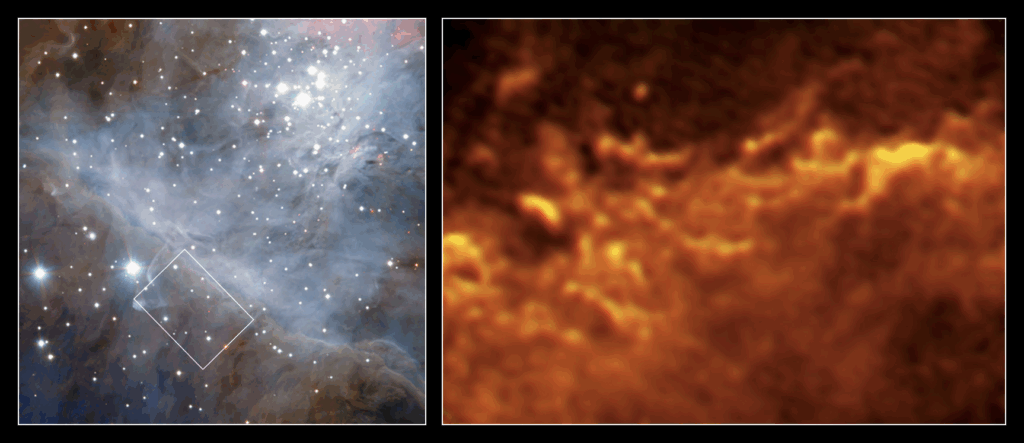
ESO/Goicoechea et al. – http://www.eso.org/public/images/potw1633a/
The ease with which light could break up CO provides a source of frustration in understanding the origin of carbon-based life. It’s so easily busted up, in principle, that there is little chance CO could have survived long enough in the universe to become the basis of planetary processes. However, work on the subject reveals the problem is more complicated than one would think. CO can be shielded from external radiation by clouds of interstellar “dust” (hydrogen and helium, plus a smattering of heavier elements). In addition, only certain wavelengths of light can actually break up CO. In the end, it’s possible for molecules like CO to survive long enough to be cycled into planetary environments and seed ecosystems.
The person suggested in this topic area was Ewine van Dishoeck, a highly respected astrochemist who helped to create this field. Her research is extremely highly regarded and cited because it’s so fundamental to answering some basic questions about how enough molecules could have survived to lead to living things.
You could also make an argument that this topic is befitting of the Nobel Prize in Chemistry, though it’s quite a synthesis of subject areas. This, again, highlights the imperfect nature of the Nobel Prize. Putting science into buckets is fraught with peril.
Wait and See
We’re just about 2 weeks away from the actual announcements. Who knows who will actually have been nominated or who might be selected?
It’s fun to speculate. It’s even more fun to get up early and listen to the announcements. I will try to live blog the fundamental science prizes again this year. Stay tuned!
Final Update, October 9, 2025
Well, the Nobel Prize in Physics for 2025 was announced and the final answer is:
NONE OF THE ABOVE!
The committee decided to honour the International Year of Quantum, marking 100 years since the foundational publication of work on what became formal quantum mechanics. They selected the realization of quantum principles in macroscopic systems, the creation of a real “Josephson Junction” which is now the basis of modern quantum sensor and computer technologies.
In a Josephson junction, one isolates two regions where electrons (or other particles) are permitted to travel by placing an energy barrier in between. Think of this like a hill. In a classical analogy, cars are free to roll without friction on either side of the hill, as on flat roads. However, to cross over the hill and get to the flat road on the other side, the car needs a minimum speed – a minimum kinetic energy – to crest the hill, roll down the other side, and keep moving on its way.
Classically, a car with too little speed cannot cross the hill, and is forbidden from making the journey. Quantum mechanics, however, describes things like cars using the language of waves. A wave is not only located in one place. It is spread out in space. There is a nonzero chance part of the wave can be found on the other side of the hill. In this way of thinking, cars can cross the barrier simply by approaching it and having their wave nature leak through the barrier. Sometimes they will simple appear on the other side of the hill, even if their speed is too low to make the “classical hill crossing”.
The Josephson Junction is when you create a circuit with such a barrier in it. Normally, electrons on one side of the barrier will forever be trapped there. You can even tune the thickness of the barrier, say, with a voltage, to bring electric current to zero (or not). Make the barrier thin enough, an a current will flow even if the barrier is still classically insurmountable to electrons. This is because they “tunnel” through the barrier, their wave properties so large they occasionally will appear on the other side of the energy barrier. A junction like this can be used to switch current on and off … the basis of all modern microcomputing
This was a nice honour for the International Year of Quantum. See more in my live blogging of the announcement.
